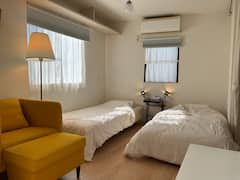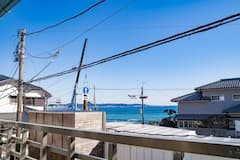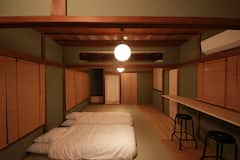Located about 50 kilometres (31 miles) south-west of Tokyo, Kamakura, or Kamakura-shi, in Japanese is a city in Kanagawa Prefecture. It was designated as a city in 1939 and is rather small, with its total area being 39.60 square kilometres (15.29 square miles). Currently, its population stands at 174,412.
Kamakura was the former political centre of Japan, back in its medieval period. Today, this city is a prominent tourist destination and houses over 10 temples. It is also popularly known for being the home to the Kotoku-in Temple’s Great Buddha, a roughly 13-metre-high (42.7-foot-high) bronze statue that existed even before the 15th-century tsunami. It is also filled with shrines and historical monuments.
Without further ado, here’s a complete guide to the very spiritual city of Kamakura:
Great Buddha of Kamakura

The Great Buddha of Kamakura is one of the the city’s major attractions. It is also one of the most famous icons of Japan. It is located in Kōtoku-in, a Buddhist temple in Kamakura. The outdoor bronze statue of Amida Buddha dates from 1252 but was officially completed in 1253 after ten years of continuous labour. It was originally located inside a large temple hall but after multiple natural disasters, such as the storms in 1248 and 1369 as well as the 15th-century tsunami, this historical statue was shifted outdoors and has sat in the open air since 1495.
Approximately 13.35 metres (43.8 feet) tall and weighing approximately 93 tonnes (102.5 tons), the statue sees visitors from both Japan and all around the world. In fact, many visitors over the years have left graffiti on the inside of the statue. There is actually a notice placed at the temple’s entrance that reads, “Stranger, whosoever thou art and whatsoever be thy creed, when thou enterest this sanctuary remember thou treadest upon ground hallowed by the worship of ages. This is the Temple of Bhudda (sic) and the gate of the eternal, and should therefore be entered with reverence.”
The Great Buddha of Kamakura
Address: 4 Chome-2-28 Hase, Kamakura, Kanagawa Prefecture 248-0016, Japan
Price: from 1.91 USD
Opening Hours: 8 am - 5:30 pm (until 5 pm from October to March)
Access: 5-10 minutes by foot from Hase Station
Contact: +81 467-22-0703
Hiking Trails
Being a densely-forested area with the nearby ocean to the south and the wooded hills all around, Kamakura is home to attractive hiking trails that are filled with historical monuments. These trails also connect the various temples in Kamakura and they are a great way to travel between some of Kamakura’s sights. There are three hills in Kamakura and each contains a hiking trail that differs largely from the others, offering amazing views and connecting different temples as well.
The first of the three, is the The Daibutsu Hiking Trail, which is located in the Western Hills. This trail connects Jochiji Temple in Kita-Kamakura with the Great Buddha (Daibutsu) in the west of the city. You can also expect to see the statue of Minamoto Yoritomo that is located in Zeniarai Benten, and the Genjiyama public park along the way. This trail takes approximately 60 - 90 minutes to complete.
The second trail is called The Tenen Hiking Trail and it connects Kenchoji Temple in Kita-Kamakura with Zuisenji Temple in the east of the city, mostly along the ridges of the hills. It takes a similar time to The Daibutsu Trail to complete and you can expect to see several tomb caves (yagura) along the trail. The trail can be accessed through the Shishimai Valley.
Lastly, The Gionyama Hiking Trail connects Myohonji Temple, Yagumo Shrine, and the Harakiri Yagura, a famous cave tomb that houses the remains of the last Hojo regent. This trail provides breathtaking views of the city that hikers can enjoy along the way. Unlike the previous two, this trail takes approximately 30 minutes to complete.
Enoshima
Enoshima is an island located just a short train ride west of Kamakura. It is situated just off the coast and it is also connected to the mainland by a bridge. This island is home to a variety of attractions, including a shrine, park, observation tower, and caves. Additionally, on some days, visitors can enjoy views of Mt. Fuji from this island.
Separated into two parts, Enoshima is a yacht harbour accessible to motorised traffic on one side, and a forested hill, which can only be explored by foot, on the other. The latter offers most of the sights and attractions. There are several shrines located around the island and they are dedicated to Benten, who is a popular goddess of good fortune, wealth, music, and knowledge. It is strongly believed that she created Enoshima before subduing a five-headed dragon that had been terrorising the area.
It is recommended for visitors of the island to purchase the Enopass, a combination ticket that includes admission to the island’s main attractions (garden, observation tower, caves) and access to the paid escalators, for 1,000 JPY (9.80 USD). There are also additional discounts offered with this pass at Benten Statue, the Enoshima Spa, and the aquarium, as well as on purchases at dedicated shops and restaurants. This pass is available at tourist information desks and the escalator ticket office.
Enoshima Island
Address: 1 Chome-9 Enoshima, Fujisawa-shi, Kanagawa-ken 251-0036, Japan
Access: Take the Enoden train from Kamakura. Journey time: 25 minutes. Cost: 260 JPY (2.55 USD)
You might be interested in these Airbnbs!
Zeniarai Benten Shrine
Zeniarai Benten Shrine is a popular shrine located in western Kamakura. Visitors flock to this shrine to “wash their money”; in Japanese, Zeniarai means “coin washing”. Many believe that money washed at the shrine’s spring will double.
It is said that the founder of the Kamakura government, Minamoto Yoritomo, ordered the shrine’s construction after a god appeared in his dream and recommended him to build the shrine in order to bring peace to the country. The dream also occurred on the day of the snake, in the month of the snake, in the year of the snake, which resulting in it being named after Benten, a Buddhist goddess associated with snakes.
Zeniarai Benten Shrine
Address: Japan, 248-0017 Kanagawa Prefecture, Kamakura
Opening Hours: 8 am - 4:30 pm
Access: 25 - 30 minute walk northwest of Kamakura Station
Beaches of Kamakura
Kamakura’s sandy beaches are filled with people sunbathing, swimming, and surfing, especially during the months of July and August. These beaches are popular getaways for locals and tourists who want to escape the nearby cities of Tokyo and Yokohama. Yuigahama and Zaimokuza Beaches are the most popular beaches in Kamakura, partly due to their convenient location and good facilities. During the summer season, these two beaches, which are located adjacent to each other, are constantly crowded with visitors.
The two beaches collectively span about 1 kilometre (0.62 miles) of coastline, which offers plenty of space for sunbathing and swimming. There are also beach huts and rental shops for beach equipment available during the summer that provide visitors with shade, changing and shower rooms, food, and drinks.
Yuigahama Beach and Zaimokuza Beach
Address: 4 Yuigahama, Kamakura, Kanagawa Prefecture 248-0014, Japan
Contact: +81 467-23-3000
Temples in Kamakura
Hokokuji Temple
Hokokuji Temple is located in the secluded hills of eastern Kamakura. This small temple is of the Rinzai Sect of Zen Buddhism and was originally founded during the Muromachi Period. It is the family temple of the ruling Ashikaga Clan and was later also adopted as the family temple of the Uesugi Clan. On the path leading the temple, you’ll be greeted by a relatively modest gate that opens through a small garden leading to the main hall.
This building was actually rebuilt in the 1920s after the original building was destroyed in the Great Kanto Earthquake. The statue of the historic Buddha (Shaka Nyorai) sits in the hall and also serves as the temple’s main object of worship. There is also the bell tower located in the main hall that comes with a simple, thatched straw roof. This was a feature of the original main hall before it burnt down.
One of the main attractions of this temple is more than 2,000 dark green bamboo stalks found in the bamboo grove located behind the temple’s main hall. There is also a tea house accessible through various narrow pathways where you can enjoy a cup of Japanese tea while enjoying views into the bamboo grove. Additionally, you can find a series of shallow caves carved into the hillsides, which are believed to hold the ashes of some of the later Ashikaga lords.
Hokokuji Temple
Address: 2-7-4 Jomyoji, Kamakura, Kanagawa Prefecture 248-0003, Japan
Price: from 1.91 USD
Opening Hours: 9 am - 4 pm. Closed December 29 - January 3
Access: Short walk from Jomyoji bus stop. Bus number: 23, 24 or 36. 30 - 40 minutes walk from Kamakura Station.
Hase Temple (Hasedera)
Hase, or Hasedara, Temple is a temple of the Jodo sect, and it is built along the slope of a hill. Its main buildings stand halfway up the slope on a terrace, which offer nice views of the city. The temple is well-known for its 9.18-metre-tall (30-foot-tall) eleven-headed statue of Kannon, the goddess of mercy. This gilded wooden statue is one of the largest wooden sculpture in Japan and it can be viewed in the temple’s main building, the Kannon-do Hall. It is believed that this statue was carved from the same tree as the similarly tall Kannon statue worshipped at Hasedera Temple in Nara Prefecture.
Upon reaching the entrance of the temple, you’ll be greeted with a garden filled with beautiful ponds. There is also a small temple hall dedicated to the goddess Benten. Sculptures of Benten and other gods can be found in a small cave, called Benten-kutsu, that is located next to the hall.
The Kannon Museum, which is located adjacent to the main hall, requires an additional entrance fee and exhibits more of the temple’s treasures, including Buddhist statues, a temple bell, and a picture scroll.There is an English pamphlet with basic explanations available. Visitors can also view the almost three-metre-tall (9.8-foot-tall) golden statue of Amida Buddha, which stands at the opposite side of the main hall.
Additionally, there are several small statues of Jizo Bodhisattva, believed to help the souls of deceased children in reaching paradise, located in the temple’s Jizo-do Hall.
Hase / Hasedara Temple
Address: 3 Chome-11-2 Hase, Kamakura, Kanagawa Prefecture 248-0016, Japan
Price: from 2.87 USD
Opening Hours: 8 am to 5:30 pm (until 5 pm from October to February)
Access: 5 minute walk from Hase Station
Contact: +81 467-22-6300
Engakuji Temple
Engakuji Temple is one of the leading Zen temples in Eastern Japan, and it stands at number two in Kamakura’s five great Zen temples. The temple is built on the slopes of Kita-Kamakura’s forested hills. The temple was founded by the ruling regent,Hojo Tokimune in the year 1282, which was one year after the second invasion attempt by the Mongols had been averted. One of the purposes of the new temple was to pay respects to the fallen Japanese and Mongolian soldiers during that time.
Upon entering the temple, you’ll be greeted with the Sanmon main gate, which dates all the way back to 1783. The temple’s main hall, the Butsuden, is located behind the gate and displays a wooden statue of the Shaka Buddha. The Butsuden was actually rebuilt after the original was destroyed during an earthquake in 1964.
There is are the Shariden Hall where a tooth of Buddha is enshrined. The temple’s large bell, ogane, stands on a hill next to a tea house in which visitors can enjoy a cup of Japanese tea and Japanese snacks. This temple is mostly frequented in the autumn season when its entrance is surrounded by many maple trees. Early December is an especially good time to visit.
Engakuji Temple
Address: Japan, 247-0247 Kanagawa Prefecture, Kamakura, Yamanouchi, 409
Price: from 2.87 USD
Opening Hours: 8 am - 4:30 pm
Access: Few steps from Kita-Kamakura Station
Contact: +81 467-22-0478
Kenchoji Temple
Kenchoji is the number one of Kamakura’s five great Zen temples, and is also the oldest Zen temple in Kamakura. This temple was founded during the Kencho era in 1253 by the ruling regent, Hojo Tokiyori. The first head priest of the temple was Rankei Doryu, a Zen priest from China. Today, Kenchoji contains a large number of temple buildings and sub-temples. It stretches from the entrance gate at the bottom of the valley far into the forested hills behind.
Upon entering the Sammon main gate, you’ll be greeted with the temple’s bell, Bonsho, which is also a designated national treasure.The first temple hall you’ll enter is Butsuden Hall, which houses the statue of the Jizo Bodhisattva. Located behind Butsuden is Hatto Hall, which is also the largest wooden temple building in Eastern Japan. A statue of Kannon is situation in the building, which also has a dragon painted on its ceiling.
The main hall, Hojo, was originally the residence of the head priest. Located approximately 20 - 30 minutes away from Kenchoji is Hansobo Shrine, which serves as a protector of Kenchoji. There is also a small observation deck there from where you can see Mt. Fuji.
The second observation deck is located just 5 minutes away where you can see views of the entire temple grounds 100 metres (328 feet) below as well as the city of Kamakura. That is also the start of the Tenen Hiking Trail.
Kenchoji Temple
Address: 8, Yamanouchi, Kamakura, Kanagawa 247-0062
Price: from 2.87 USD
Opening Hours: 8:30 am - 4:30 pm
Access: 15 - 20 minute walk from Kita-Kamakura Station
Contact: +81 467-22-0981
Jomyoji Temple
Another Zen temple in Kamakura, Jomyoji Temple is located in the eastern hills and is ranked 5th among the five great Zen temples of Kamakura. It was founded by the Ashikaga family, and the complex had seven buildings and several pagodas during its peak. Many of the temple’s structures were destroyed by fire over the centuries. Today, only the original main hall, reception hall, main gate, and warehouse remain. The main hall sits at the end of a garden and houses a statue of the historical Buddha, Shaka Nyorai.
The temple also has a tea house where visitors can enjoy a cup of tea for a small fee while enjoying the view of the nice dry garden. There is a cemetery located behind the temple’s main hall and there is also a path that leads up to a western-style restaurant.
Jomyoji Temple
Address: 3-8-31 Jomyoji, Kamakura, Kanagawa Prefecture 248-0003, Japan
Price: from 0.96 USD
Opening Hours: 9 am - 4:30 pm
Access: A short walk from Jomyoji bus stop, 30 - 40 minutes’ walk from Kamakura Station.
Contact: +81 467-22-2818
Meigetsuin Temple
Meigetsuin Temple was founded in 1161 and it is a temple of the Rinzai Zen Sect. It is also referred to as the Ajisaidera, or “Hydrangea Temple”, because of the hydrangea blooms in abundance on the temple grounds during the rainy season around the month of June. Also, 95 percent of the hydrangeas here are of the Hime Ajisai, or “Princess Hydrangea”, variety.
The temple is said to have been built by a man for his father who had died during the struggle between the Taira and Minamoto Clans in the late Heian Period. Later, the temple became part of a larger temple complex called Zenkoji. However, Zenkoji was abolished during anti-Buddhist movements soon after the Meiji Restoration, leaving only Meigetsuin as the sole surviving temple today.
The temple’s main hall features a popular circular window, which frames the scenery of the inner garden behind it. Many visitors can be seen taking photos here. The inner garden is filled with beautiful irises and is only open to visitors during two periods of about two weeks per year: in June and November / December. The Founder’s Hall is a thatched roof building that enshrines the temple’s founder and also stores mortuary tablets of the succeeding head priests. There is a cave located next to the hall that was dug out centuries ago and is among the largest found in the hills around Kamakura.
Meigetsuin Temple
Address: Japan, 247-0062 Kanagawa Prefecture, Kamakura, Yamanouchi, 189
Price: from 2.87 USD
Opening Hours: 9 am - 4 pm. 9 am - 5 pm in June
Access: 10-minute walk from Kita-Kamakura Station
Contact: +81 467-24-3437
Ankokuronji Temple
Ankokuronji Temple is of the Nichiren sect of Japanese Buddhism and is located along the hills in the southeast of Kamakura. It was founded in 1253 by Nichiren himself when he first came to Kamakura, and he is said to have lived at the temple for several years. There is a short hiking trail where visitors can walk through the wooded hills around the temple buildings while enjoying the nice views of the city along the way. It is important to note that parts of the trails are quite steep and should only be explored with good walking shoes and during dry weather.
Ankokuronji Temple
Address: 4 Chome-4-18 Omachi, Kamakura, Kanagawa Prefecture 248-0007, Japan
Price: from 0.96 USD
Opening Hours: 9 am - 5 pm
Access: 20 - 25 minutes from Kamakura Station.
Contact: +81 467-22-4825
Zuisenji Temple
Zuisenji Temple is a Zen temple located in the far east of Kamakura, in the back of a narrow valley, and surrounded by wooded hills. It is actually a branch temple of Engakuji Temple. The temple was founded by Muso Kokushi, who is a leading Zen master of his time and one of Japan’s most famous garden designers. Behind the temple’s main hall lies its pure Zen rock garden that it is known for and which was designed by Muso himself. The temple is also filled with an abundance of plum trees and flowers, contributing to its attractiveness.
Zuisenji Temple
Address: 710 Nikaido, Kamakura, Kanagawa Prefecture 248-0002, Japan
Price: from 1.91 USD
Opening Hours: 9 am - 5 pm
Access: 10 - 15 minutes from Zuisenji bus station.
Contact: +81 467-22-1191
Jochiji Temple
Number four of Kamakura’s five great Zen temples, Jochiji Temple is a branch of the Engakuji school of the Rinzai sect of Zen Buddhism. Engakuji Temple stands a few hundred metres away on the opposite side of the railway tracks.
Jochiji Temple was founded in 1283 by members of the Hojo family due to the premature death of a son. The temple was formally a large complex with many buildings and sub-temples. Today, it is much smaller and exudes a more calming atmosphere. Its main hall houses a Buddhist trinity of the Amida Buddha, Shaka Buddha, and Miroku Buddha, which is also the temple’s main object of worship.
Behind the main hall, there is a circular path leading through the temple garden and past a graveyard as well as some caves. The Daibutsu Hiking Trail starts right next to the temple where the Great Buddha can be access within an hour by foot.
Jochiji Temple
Address: 1402 Yamanouchi, Kamakura, Kanagawa Prefecture 247-0062, Japan
Price: from 1.91 USD
Opening Hours: 9 am - 4:30 pm
Access: 10-minute walk from Kita-Kamakura Station
Contact: +81 467-22-3943
Myohonji Temple
Myohonji Temple is located along the southeastern hills of Kamakura and is of the Nichiren sect of Japanese Buddhism. It was founded by Hiki Yoshimoto in 1260 and features a statue of Nichiren to the left of the main hall. The temple, which is connected to the Gionyama Hiking Trail, is located near neighbouring temples and shrines.
Myohonji Temple
Address: 1-15-1 Omachi, Kamakura, Kanagawa Prefecture 248-0007, Japan
Price: Free
Opening Hours: 9 am - 5 pm
Access: 10-minute walk east of Kamakura Station.
Contact: +81 467-22-0777
Tokeiji Temple
Tokeiji Temple is a small temple of the Engakuji school within the Rinzai sect of Zen Buddhism. Its head temple, Engakuji Temple, stands just a few hundred metres away on the opposite side of the railway tracks. The temple was founded by the wife of the regent Hojo Tokimune in 1285, after the death of young Tokimune. The temple served as a shelter for women who suffered abuse by their husbands until the end of the Edo period. For the women who sought divorce, they could only obtain an official divorce after staying in the temple for 3 years.
Tokeiji Temple
Address: 1367 Yamanouchi, Kamakura, Kanagawa Prefecture 247-0062, Japan
Price: from 1.91 USD
Opening Hours: 8:30 am - 5 pm
Access: 5-minute walk from Kita-Kamakura Station
Contact: +81 467-22-1663
Explore the spiritual sculptures of Japan
With multiple temples, shrines, and breathtaking views, there’s just something about Kamakura that the rest of Japan doesn’t offer. This charming city, whose history is entwined with Buddhism, is definitely a place that you should include when visiting Japan. Be prepared to feel spiritually enlightened and calm during your trip!
History
Get Trip101 in your inbox
Unsubscribe in one click. See our Privacy Policy for more information on how we use your data























































Create an account to